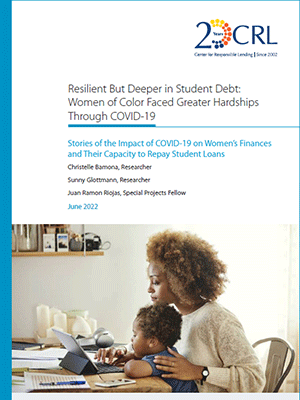
Women carry about two-thirds of the $1.7 trillion of federal student debt, with Black women more than twice as likely as white men to owe more than $50,000 in undergraduate student loan debt.
Women carry about two-thirds of the $1.7 trillion of federal student debt, with Black women more than twice as likely as white men to owe more than $50,000 in undergraduate student loan debt. The COVID-19 crisis has exacerbated the financially unstable positions of many women, furthering gender disparities. The Center for Responsible Lending (CRL) commissioned four focus groups with women who voluntarily or involuntarily left the workforce during the pandemic and conducted descriptive analysis on publicly available datasets. CRL’s research sought to analyze how women’s finances have changed over the course of the past two years and what implications these changes have had on women’s long-term financial well-being and their ability to repay outstanding education debt. This research fills in a gap in academic literature by centering the perspectives and experiences of female borrowers.
Overall, findings indicate the widespread disruption in employment due to the pandemic have had a profound impact on women, their families, and their finances. Despite demonstrating immense resiliency, the worst outcomes have disproportionately harmed women of color. Recognizing that the COVID-19 crisis has reshaped women’s relationship to work and their ability to save for the future, it is essential to tailor policy solutions that will enable women to meet their short-term financial obligations and not have outstanding student loan debt encumber long-term financial planning.
While the temporary pause on student loan payments during the pandemic allowed women to focus on immediate expenses, most of the women we spoke with do not feel prepared to resume payments without difficulty. To alleviate the financial suffering of millions of women, policymakers must provide universal debt relief and improve repayment options for the millions of borrowers whose outstanding student loan debt is preventing them from building wealth.
The results of the analysis:
- Due to increased childcare responsibilities, as well as the high-contact, low-wage nature of many women’s occupations, women of color and women in jobs who could not go remote have less job security today than pre-pandemic.
- The economic gains made through 2021 were not shared equally across racial groups. Women of color continue to experience financial hardship paying for necessities.
- Student loan debt burdens remain at staggering levels, despite the payment pause. Black women and Latina borrowers typically have higher student loan balances than white women, making repayment more difficult.
- Although the focus group participants found the student loan payment pause helpful, they worry about their ability to start paying again once payments resume.
- Because of the difficulties faced repaying their student loans, women are reluctant to incur more student loan debt for themselves or their children.